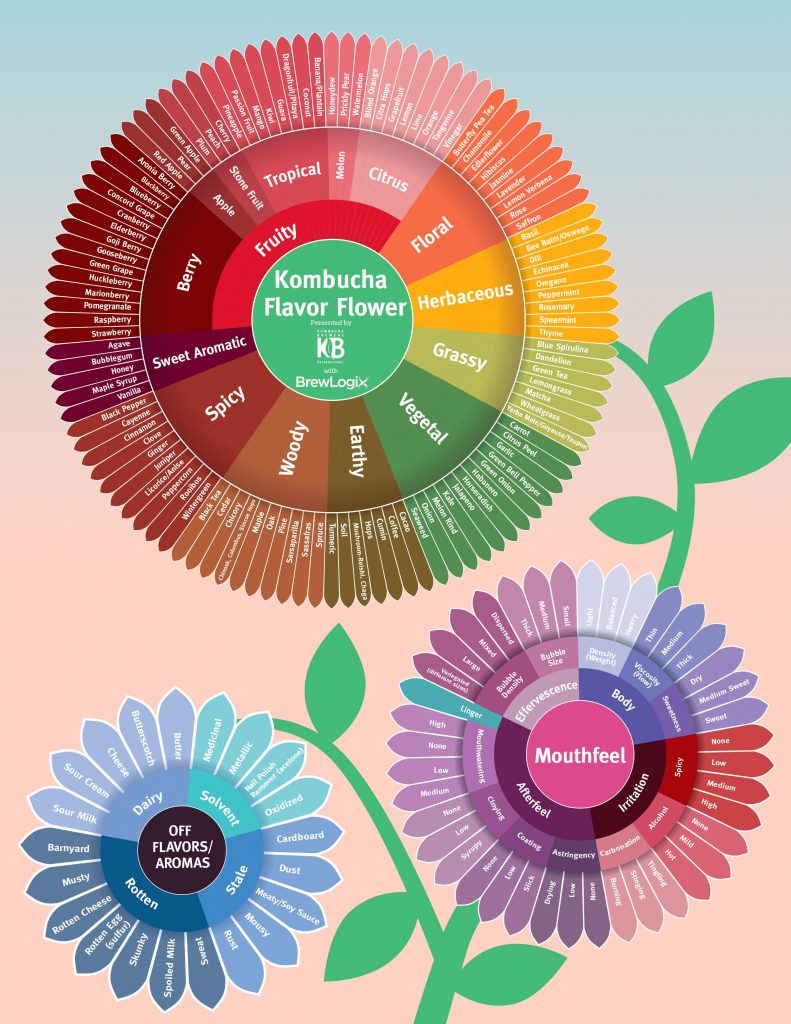Find Your Kombucha’s Sensory Profile with the NEW Flavor Flower
A New Tool for the Kombucha Drinker’s Palate Like all the finer things in life, many of which also happen to be fermented, Kombucha is often an acquired taste. Over time, the Kombucha drinker’s palate becomes more sophisticated – able to discern subtle notes from the tea, flavorings or organisms in the fermentation process. To […]
A New Tool for the Kombucha Drinker’s Palate
Like all the finer things in life, many of which also happen to be fermented, Kombucha is often an acquired taste. Over time, the Kombucha drinker’s palate becomes more sophisticated – able to discern subtle notes from the tea, flavorings or organisms in the fermentation process. To support this evolution,, KBI is proud to present “The Kombucha Flavor Flower.”
After months of development with industry stakeholders, we have created a 108 petal “Flavor Flower” that provides the vocabulary for identifying the flavors of the brew, as well as 2 offshoot “flowers” that describe the mouthfeel and potential off flavors.
The development of the Kombucha Flavor Flower is a crucial next step to support our blossoming industry, elevating the way consumers and brewers alike savor the unique taste we’ve grown to love.
Kombucha Sensory Program
When it comes to novel foods and beverages, you might get a consumer to try your product once. That means that first sip has to wow them. If quality assurance beyond pH and Brix testing isn’t part of your brewing process, you may be sending the wrong message with your brew. Establishing a sensory testing program ensures that the brewmaster’s flavor profiles are being executed on a consistent basis, batch after batch.
In addition to the Flavor Flower, KBI also developed a sensory rating chart that any member can download and use to start their own sensory program immediately. Together, when these tools are used on a regular basis, baseline profiles emerge that future products can be compared with to ensure they are meeting the quality standards of the brand.
To learn more about sensory training and how it can improve your product, don’t miss Lindsay Barr of Draught Labs speaking at KombuchaKon 2022 – Leveling Up.

Flavor Flower
When reinventing the wheel, KBI drew inspiration from the flavor wheels from beer, wine, spirits, tea and coffee. In the main flower, we’ve organized the type of flavor into recognizable categories – citrus, berry, and so forth – with individualized flavor descriptors. Sometimes the descriptors will be identical to the flavoring agents, other times, they may not.
If green tea or yerba mate is used as the base, we’d expect grassy notes to dominate. Fresh pressed turmeric juice evokes rich earthy tones, however if the turmeric is powdered, the flavor may come across as more citrusy. If you’re using herbs but getting a grassy or vegetal flavor, your kombucha may not be communicating its flavors clearly.
Mouthfeel Flower
How a food or beverage feels in the mouth is just as important as its flavor. Ever wonder how to differentiate the texture of your kombucha? We all know some kombuchas are more bubbly than others, but they also have other characteristics such as linger and body. An unfiltered Kombucha may have a rounder flavor that hits a different part of the palate along with a softer bubble than one that has been filtered or force carbonated. The interplay of both flavor and mouthfeel create a sensation, a story, if you will, of the fermentation that changes when any aspect is not in balance.
All of these factors contribute to the way customers perceive the beverage. Look at the Mouthfeel flower to begin dialing in how your kombucha FEELS to customers, and not just what its flavors are.
Off-Flavors Flower
With the Off-Flavors flower, you’ll be able to troubleshoot problems. Does your latest batch taste off somehow? Maybe that strange taste in your latest batch that has a rotten egg or the ever dreaded mouse taint flavor or smell. If there’s a sharp flavor to it, check the chart: does it have a taste of nail polish remover or metal? Such flavors are associated with deviations in fermentation. As the science of Kombucha is relatively new, we are in the early stages of fully understanding how the microbes create both good and bad flavors. Some of these issues are similar to those from the beer or wine industry and we can research using these terms.
Take a look and see if you can find your kombucha’s flavors on our chart, and help establish a new standard for sensory development in kombucha. Members can access a PDF version of the Flavor Flower as well as a sensory rating chart here. (Not a member? Join us today!)



